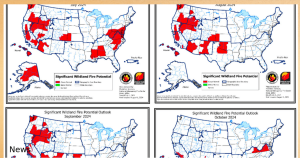On Tuesday, the FDA revealed that the results of a monthlong investigation, conducted by both the FDA and the Centers for Disease Control and Prevention, have identified untreated canal water from a farm in Palm Beach County, Florida, as the probable cause of the salmonella outbreaks that have affected 449 individuals across 31 states.
According to a statement released by the FDA, it has been established through laboratory, epidemiological, and traceback data that the source of the outbreak is likely to be cucumbers originating from Bedner Growers, Inc. in Boynton Beach, Florida. The distributors of these cucumbers, Fresh Start Produce Sales Inc., had voluntarily recalled the product in May.
According to the CDC, the outbreak has not resulted in any fatalities, but it has led to 125 hospitalizations. In Florida alone, 52 individuals have reported salmonella infections related to the outbreak as of July 1.
According to the FDA, Bedner Growers’ water analysis revealed the presence of a particular strain of Salmonella Braenderup, which is responsible for some of the illnesses in the current outbreak. Furthermore, soil and water samples collected at the site indicated the existence of various other salmonella types. The authorities are currently conducting investigations to determine if these other strains are also responsible for causing illnesses and to identify any additional sources.
The FDA pointed out that the grower in question is not responsible for all the illnesses that occurred during the outbreak.
The Florida cucumbers that were recalled have certain characteristics to help identify them. They are whole, with a dark green color, and have a diameter of around 1.5-2.0 inches and a length of 5-9 inches. It’s important to note that mini cucumbers and English cucumbers were not a part of this recall.
At first, the outbreak of Salmonella was being treated as two distinct outbreaks by agencies and local partners. One was caused by Salmonella Africana, while the other by Salmonella Braenderup. However, the CDC and FDA combined them into one outbreak due to similarities in demographics and the types of food that the infected individuals consumed before falling sick.
According to the FDA, 31 states and the District of Columbia have reported a total of 449 cases of infection as of July 1. Out of these, 215 cases were found to be infected with Salmonella Braenderup, and almost 70% of these cases reported consuming cucumbers.
According to the FDA, the public is not currently at risk as Bedner Growers has already finished its cucumber growing and harvesting season and there are no products from this farm available for sale.
Other salmonella outbreaks
According to recent reports, the Centers for Disease Control and Prevention (CDC) is currently looking into two separate outbreaks. The first outbreak is related to backyard poultry, which has resulted in 109 individuals falling ill, with 33 of them requiring hospitalization. The second outbreak is linked to pet bearded dragons and has infected 15 people. The CDC is actively investigating both outbreaks to determine the cause and prevent further spread.
Earlier this year, an outbreak of salmonella was traced back to organic basil sold at Trader Joe’s. This outbreak impacted 12 individuals across seven states, including Florida, and resulted in one person being hospitalized.
Where were people infected with salmonella?
The CDC has reported that those affected by the salmonella outbreak are located in:
-
- Alabama: 4
- Arkansas: 1
- Connecticut: 7
- Delaware: 2
- District of Columbia: 1
- Florida: 52
- Georgia: 33
- Illinois: 4
- Indiana: 2
- Iowa: 4
- Kentucky: 17
- Maine: 3
- Maryland: 13
- Massachusetts: 11
- Michigan: 9
- Minnesota: 9
- Missouri: 3
- New Jersey: 19
- Nevada: 1
- New York: 57
- North Carolina: 22
- Ohio: 18
- Oklahoma: 1
- Pennsylvania: 60
- Rhode Island: 7
- South Carolina: 20
- Tennessee: 20
- Texas: 2
- Vermont: 1
- Virginia: 43
- Washington: 1
- Wisconsin: 2
According to the CDC, the outbreak could extend beyond the states with confirmed cases, and the actual number of affected individuals is probably greater than the reported figures. The reason for this is that numerous individuals recuperate without seeking medical attention and are therefore not subjected to salmonella testing.
What is salmonella?
According to the fact page of the Centers for Disease Control and Prevention, Salmonella bacteria are responsible for causing illness in humans.
According to the Centers for Disease Control and Prevention (CDC), Salmonella has the potential to cause illness among individuals, leading to symptoms like stomach cramps, fever, and diarrhea. The effects of the infection can last up to a week, with symptoms usually occurring anywhere from six hours to six days after infection. While most cases of Salmonella infections are self-limiting, hospitalization may be required for some individuals.
According to the CDC, Salmonella bacteria are responsible for causing approximately 1.35 million infections, 26,500 hospitalizations, and 420 deaths in the United States annually. It is stated that food is the primary source of most of these illnesses.
What you should do
If you still have any cucumbers left from the farm, it is highly improbable that they are still safe to eat. In case of doubt, it is best to refrain from consuming them. As per the CDC’s guidelines, it is advisable to clean any surfaces that these cucumbers may have come in contact with using hot soapy water or a dishwasher.
If you experience any of the following severe symptoms, it is important to seek medical attention by calling a doctor:
-
- Diarrhea and a fever higher than 102°F
- Diarrhea for more than 3 days that is not improving
- Bloody diarrhea
- So much vomiting that you cannot keep liquids down
- Signs of dehydration, such as:
- Not peeing much
- Dry mouth and throat
- Feeling dizzy when standing up
-
- Not peeing much
- Dry mouth and throat
- Feeling dizzy when standing up



